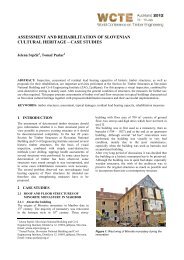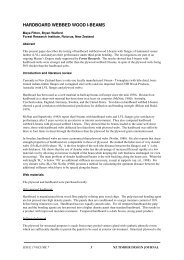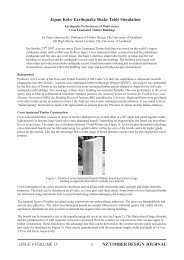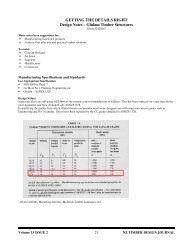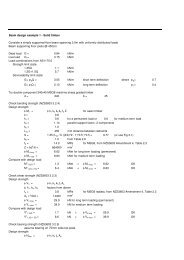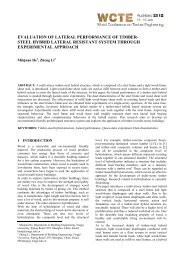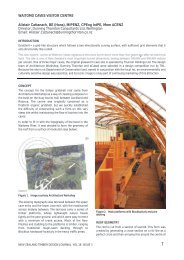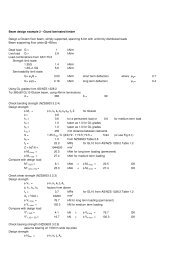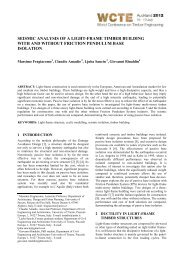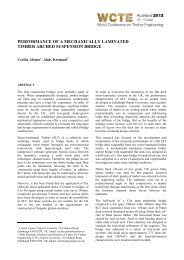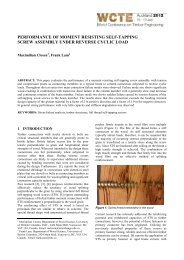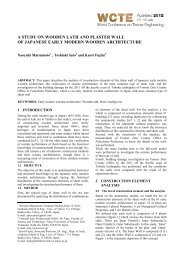00078 Lin Hu - Timber Design Society
00078 Lin Hu - Timber Design Society
00078 Lin Hu - Timber Design Society
You also want an ePaper? Increase the reach of your titles
YUMPU automatically turns print PDFs into web optimized ePapers that Google loves.
2.2.2 Subjective Evaluation<br />
The key objective of the subjective evaluation of<br />
vibration performance is to define the maximum<br />
annoying vibration level that can be acceptable to the<br />
majority of occupants of residential floors.<br />
To more closely mimic normal living conditions during<br />
subjective performance evaluations, the CLT floor<br />
assemblies were carpeted and furnished with a cabinet<br />
and two vases filled with water and flowers, as shown in<br />
Figures 5 and 6. The reason for decorating the china<br />
cabinet using flowers and water is because these objects<br />
are good indicators of floor excessive vibrations. If the<br />
floor is vibrating at high level when a person is walking<br />
by the cabinet, he/she will notice the flower and the<br />
water moving. In Figure 6, you also can see some kind<br />
of china cabinet with glassware. It has been observed<br />
that the glassware in the china cabinet is another good<br />
indicator of excessive vibrations. Typically, with poor<br />
floors, one can easily notice the rattling of glassware in<br />
the room. In these Figures, you could also see a chair<br />
located in the centre of the floor. During the subjective<br />
evaluation, if the person is sitting on the chair and feels<br />
the floor vibrating when someone is walking by the<br />
chair, then the floor vibration is most likely not<br />
acceptable.<br />
Figure 6: Subjective evaluation while the evaluator is<br />
sitting, feeling, and observing the floor movement<br />
The evaluator was then asked to sit on the chair, while<br />
another person would walk on the floor according to a<br />
pre-designated pattern (Figure 6). The walking pattern is<br />
such that the person walks at least two times along the<br />
two diagonal directions from one corner of the floor to<br />
the other, then walks at least two times along the middle<br />
lines in the parallel and perpendicular directions of the<br />
subfloor panels. Again the evaluator was observing the<br />
three clues, i.e. seeing, hearing and feeling regarding<br />
floor vibration performance. Immediately after the<br />
evaluation, the evaluator is asked to fill out a<br />
questionnaire which provided an overall performance<br />
rating for the floor as well as a score for the three key<br />
performance-related clues.<br />
2.2.3 Static Concentrated Load Test<br />
This test was conducted to determine the maximum<br />
static deflection of the floor under a 1 kN concentrated<br />
static load. This is a measure of the entire stiffness of the<br />
floor.<br />
Figure 5: Subjective evaluation while the evaluator is<br />
walking, feeling, and observing the floor movement<br />
At least twenty persons were asked to evaluate the<br />
performance of a floor subjectively. Only one evaluator<br />
was allowed on the floor at a time. He or she first walked<br />
freely on the floor while observing clues related to floor<br />
performance (Figure 5). The clues included movement of<br />
the flowers and the water, rattling of the china cabinet,<br />
and feeling the movement of the floor.<br />
The basic elements needed to measure static deflection<br />
under a concentrated load are: 1) a stable reference from<br />
which to measure floor movement, 2) an accurate and<br />
sensitive deflection measuring device, and 3) a mobile<br />
loading system. In this study, the concrete ground floor<br />
was used as the reference. Two electronic gauges having<br />
a resolution of 0.001 mm were used as the deflection<br />
measuring devices as shown in Figure 7. The deflection<br />
gauges were mounted to the free ends of two rods in<br />
contact with the concrete ground floor surface. The end<br />
of one deflection gage was fixed to the bottom of the<br />
middle point of the centre CLT panel to measure the<br />
static deflection of the floor centre. The end of the<br />
second deflection gauge was fixed to the bottom of the<br />
middle point of the joint of two CLT panels to measure<br />
the static deflection of the joint. The concentrated static<br />
load was applied by a person standing over each CLT<br />
panel’s centre, floor edges and the joints in turn while<br />
recording the measurement at the gauge location. Figure<br />
8 shows the static loading process using the tester’s<br />
weight. The deflection profile of the floor was generated<br />
from a complete set of measurements. Three



